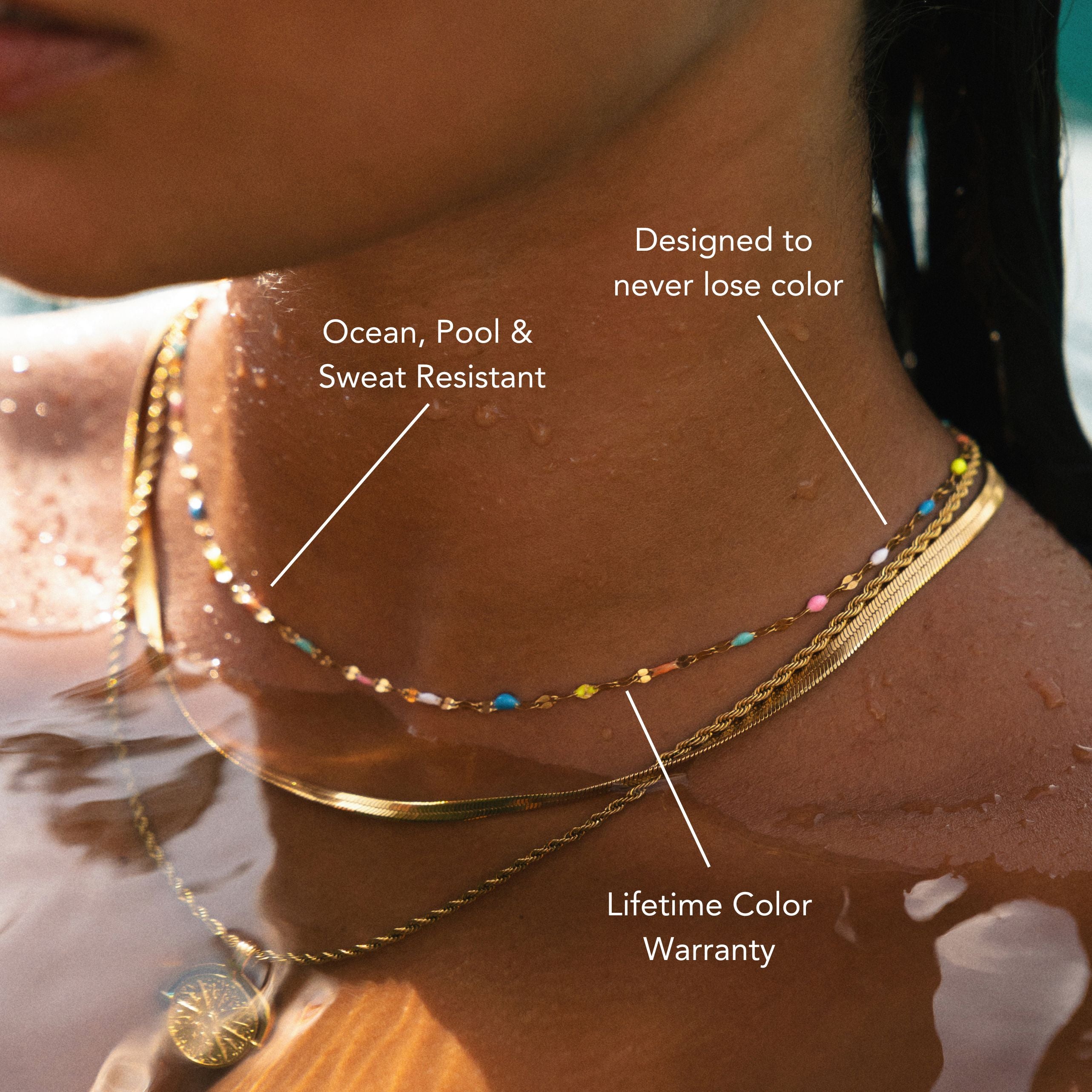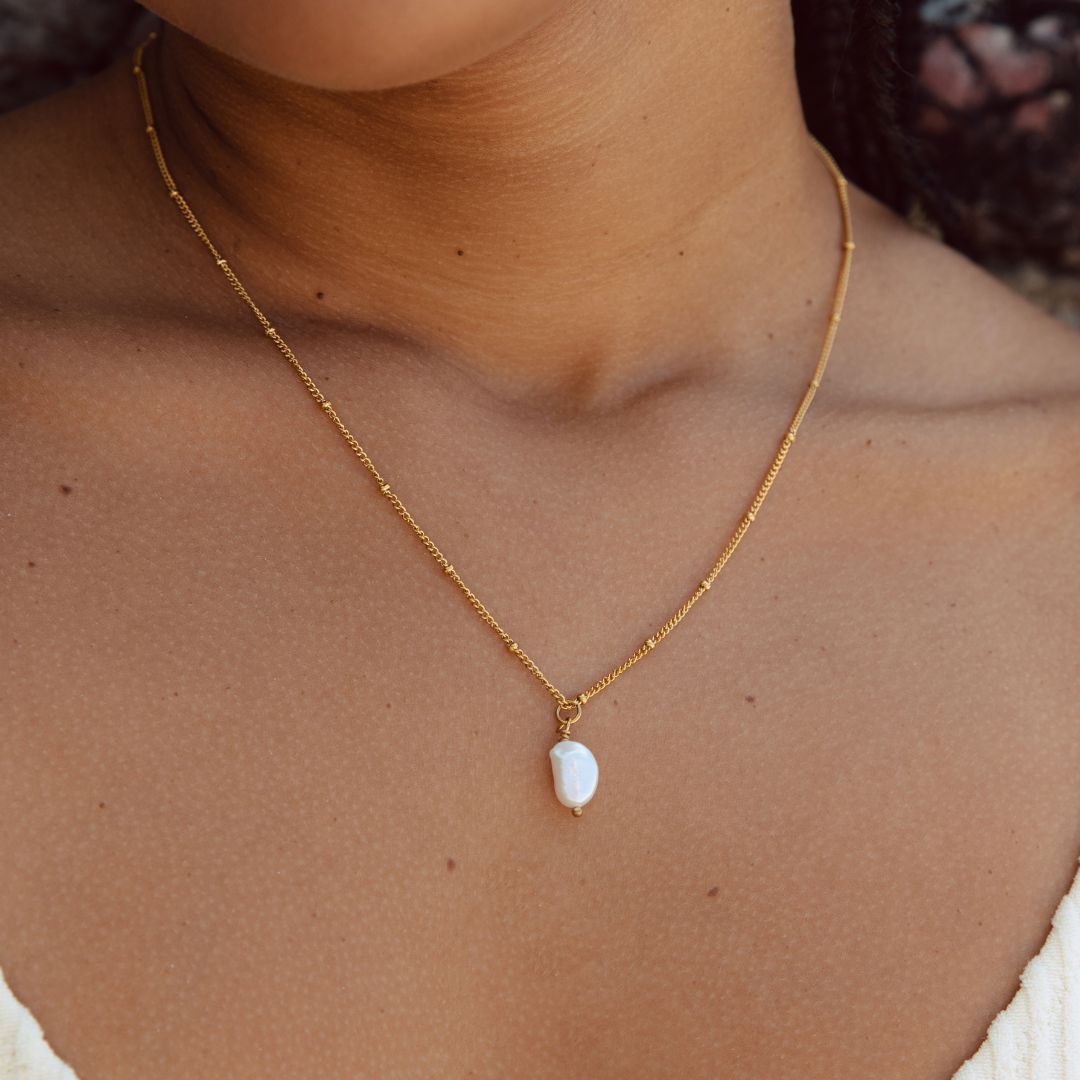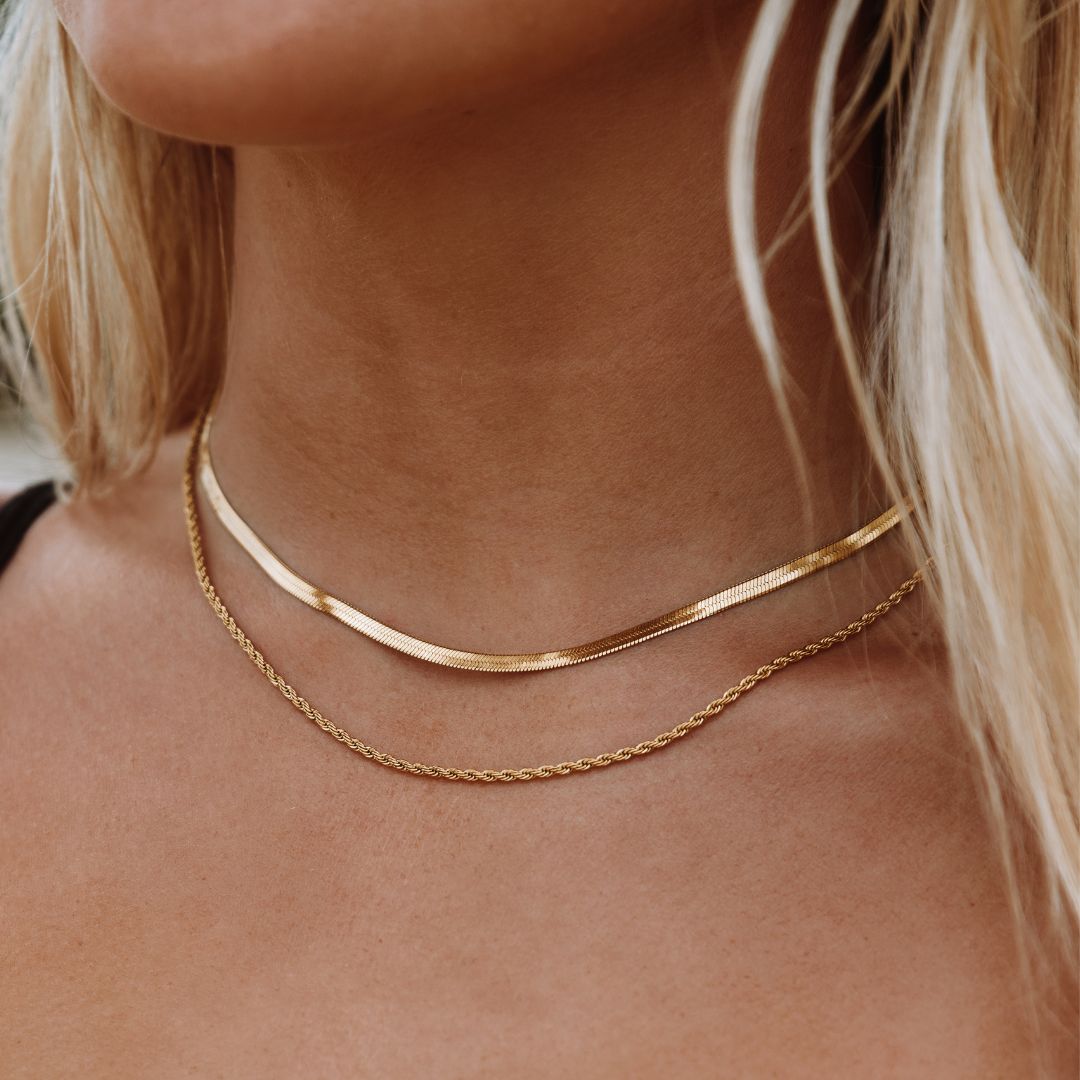
Quick Tips on How to Make Silver Shiny
Wondering how to make silver shiny again? Start with a simple baking soda paste—mix three parts baking soda with one part water, and gently rub it on tarnished areas. You can also try the aluminum foil method: line a bowl with foil, sprinkle baking soda, and pour hot water over your silver. For a quick fix, non-gel toothpaste works wonders too. Soaking your pieces in a vinegar and baking soda solution is another effective method. Regular maintenance is crucial, so polish your silver every few months and store it in a dry, cool place. Explore our waterproof jewelry collection for sparkling pieces that require minimal upkeep.
Understand Silver Tarnish
Silver tarnish is a common issue that affects many silver items, and understanding it's key to keeping your pieces looking their best. Tarnish occurs when silver reacts with sulfur compounds found in the air and various materials, leading to a dull, darkened appearance.
The primary causes of tarnish include exposure to moisture, air pollution, and even certain foods. For example, onions, eggs, and some types of cheese can accelerate tarnishing when silver comes into contact with them.
To effectively prevent tarnish, you can take several proactive steps. First, store your silver items in a cool, dry place, preferably in anti-tarnish cloth or bags designed specifically for this purpose.
Avoid wrapping silver in newspaper, as the ink can contribute to tarnishing. Regularly polishing your silver can also help remove any tarnish that starts to form. Additionally, consider using silica gel packets in storage areas to absorb moisture.
Use Baking Soda Paste
To restore your silver's shine, start by gathering your materials: baking soda, water, and a soft cloth.
Next, mix the baking soda with a bit of water to create a paste, then apply it to your tarnished pieces.
Once you've scrubbed away the tarnish, rinse and dry your silver to reveal its sparkling beauty.
Gather Your Materials
When it comes to making your silver shiny again, gathering the right materials is essential, and a simple baking soda paste is one of the best options.
Start by collecting your cleaning tools. You'll need a small bowl for mixing, a spoon for stirring, and, of course, baking soda. This common household item effectively removes tarnish from silver.
Next, grab some polishing cloths. Microfiber or cotton cloths work well, as they provide gentle abrasion without scratching your silver. These will help you apply the baking soda paste and polish the surface for a brilliant shine.
Don't forget about storage containers! Once you've cleaned your silver, store it in a tarnish-preventive container to keep it looking its best.
Consider using anti-tarnish strips or bags designed specifically for silver, as they can greatly reduce tarnishing over time.
Apply the Paste
Now that you've gathered your materials, it's time to apply the baking soda paste to your silver pieces. Start by mixing three parts baking soda with one part water to create a thick paste.
Take a soft cloth or sponge and dip it into the paste, ensuring it's well-coated but not dripping.
Gently rub the paste onto the tarnished areas of your silver. Use circular motions, applying light pressure to avoid scratching the surface. Focus on the spots with heavy tarnish, but don't neglect the entire piece, as thorough silver cleaning boosts the overall shine.
Let the paste sit for a few minutes to enhance its effectiveness in tarnish prevention. This allows the baking soda to break down the tarnish and restore the silver's natural luster.
If you notice particularly stubborn spots, you can apply a bit more paste and work on those areas again.
Rinse and Dry
After letting the baking soda paste work its magic, it's time to rinse your silver pieces to remove any residue.
Start by holding your silver under warm running water. This rinse technique helps wash away the paste and any tarnish it has lifted. Make certain to be gentle, especially with intricate designs, to avoid scratching the surface.
If you're dealing with larger items, consider using a bowl of warm water to soak them briefly. Gently wipe the pieces with a soft, lint-free cloth or sponge to guarantee all paste is removed. Avoid using abrasive materials, as they can cause damage.
Once rinsed, it's vital to dry your silver properly. Opt for a clean, soft towel for drying methods.
Pat the pieces dry instead of rubbing them, as this helps prevent scratches. Confirm they're completely dry to avoid water spots or further tarnishing.
Try Aluminum Foil Method
If you're looking for a quick and effective way to make your silver shiny again, the aluminum foil method is a great option. This technique employs the electrolysis method to remove tarnish without harsh chemicals, making it both safe and simple.
To get started, gather a few materials: a bowl, some aluminum foil, baking soda, and hot water. First, line the bowl with aluminum foil, shiny side up. Next, sprinkle a generous amount of baking soda over the foil.
Place your tarnished silver pieces on top, ensuring they touch the foil. Then, carefully pour hot water into the bowl, fully submerging the silver items.
As the hot water interacts with the baking soda and aluminum foil, a chemical reaction occurs, effectively transferring the tarnish from the silver to the foil. You might notice bubbles forming, which is a good sign that the process is working.
Allow the pieces to soak for a few minutes, then remove them, rinse thoroughly under cool water, and dry with a soft cloth. This aluminum foil method isn't only efficient but also restores your silver's shine in no time!
Employ Toothpaste Technique
To make your silver shiny using toothpaste, start by choosing a non-gel, non-whitening toothpaste for the best results.
Apply a small amount to a soft cloth and gently rub it over your silver pieces, ensuring you cover all tarnished areas.
Once you're done, rinse thoroughly with warm water to reveal your sparkling silver!
Choose the Right Toothpaste
When it comes to making silver shine, choosing the right toothpaste can make all the difference. Not all toothpaste types are created equal, and some can be more effective than others when it comes to polishing silver.
You'll want to avoid any toothpaste that contains abrasive particles, as these can scratch and damage your silver items. Instead, opt for a non-gel, non-abrasive formula.
Look for toothpaste that includes mild whitening agents. These agents can help lift tarnish without harming the surface of your silver. Toothpaste that's specifically labeled for sensitive teeth often has a gentler formula, making it a good choice for delicate silver pieces.
Remember to steer clear of any products that have added dyes or strong flavoring. These ingredients might leave residues that could dull the shine instead of enhancing it.
Ultimately, picking the right toothpaste is key to achieving that bright, lustrous finish for your silver.
Apply and Rinse Thoroughly
With your chosen non-abrasive toothpaste in hand, it's time to apply it to your silver pieces for ideal shine. Squeeze a small amount of toothpaste onto a soft cloth or your fingertips. Gently rub it onto the silver, focusing on any tarnished areas.
Make certain to apply thoroughly, using circular motions to lift away dirt and tarnish without scratching the surface. Don't rush—take your time to guarantee every nook and cranny gets the attention it needs.
Once you've covered the silver with toothpaste, let it sit for a minute or two to penetrate any stubborn tarnish. Afterward, it's time to rinse effectively. Hold your silver under lukewarm running water, making sure all the toothpaste is washed away.
This step is essential, as leftover toothpaste can leave a residue that dulls the shine.
After rinsing, use a soft, dry cloth to buff your silver gently. This final touch will enhance its luster even further. Voilà! Your silver pieces should now gleam beautifully, ready to be displayed or worn.
Regularly using this technique will keep your silver shining for years to come.
Soak in Vinegar Solution
For a quick and effective way to restore your silver's shine, soaking it in a vinegar solution can work wonders.
Vinegar benefits your silver by helping to dissolve tarnish and grime, leaving it looking bright and polished. To create your solution, mix one cup of white vinegar with two tablespoons of baking soda in a bowl. Be prepared for some fizzing as the baking soda reacts with the vinegar!
Once you've prepared your solution, submerge your silver pieces fully. The soaking duration is typically around two to three hours, but if you're dealing with particularly stubborn tarnish, you might want to extend it up to five hours.
Keep an eye on your silver during this time to guarantee it doesn't soak too long, which could lead to damage.
After soaking, remove your silver and gently scrub it with a soft cloth or sponge to remove any remaining tarnish. Rinse the pieces thoroughly under warm water and dry them completely with a clean cloth.
You'll be amazed at how effectively this simple method restores the shine to your silver items!
Utilize Commercial Silver Polish
After soaking your silver in a vinegar solution, you might find that some pieces require a more thorough cleaning. This is where commercial silver polish comes into play. There are various silver polish types available, ranging from creams to sprays, so you can choose one that best suits your needs.
When using silver polish, start by reading the label for specific instructions. Generally, you'll want to apply a small amount of polish to a soft cloth or sponge. Use gentle, circular motions to work the polish into the silver, ensuring you cover all tarnished areas. Pay close attention to intricate designs where tarnish can hide.
Once you've polished the entire piece, wipe away any excess polish with a clean, dry cloth. This step is essential as it prevents any residue from dulling the shine.
For heavily tarnished items, you may need to repeat the application process. Remember, patience is key—allowing the polish to sit for a bit can enhance its effectiveness.
With the right silver polish and application techniques, your silver will shine beautifully in no time!
Clean With Lemon Juice
Lemon juice is often an overlooked yet effective solution for cleaning silver. It's a natural cleaner that not only brightens your silver pieces but also offers some impressive lemon benefits. The acidity in lemon juice helps break down tarnish, making it easier for you to restore your silver's shine without harsh chemicals.
To clean your silver with lemon juice, start by mixing equal parts lemon juice and water in a bowl. Dip a soft cloth or sponge into this mixture, then gently rub the tarnished areas of your silver. You'll notice the tarnish starting to lift almost immediately.
For tougher spots, you can sprinkle a little baking soda onto the cloth along with the lemon juice, creating a paste that provides extra abrasion without scratching.
After you've finished cleaning, rinse your silver under lukewarm water to remove any residue, then dry it thoroughly with a clean, soft cloth. This method not only rejuvenates your silver but also leaves it with a fresh, citrusy scent.
Regular Maintenance Tips
Maintaining the shine of your silver pieces requires just a few simple habits that can make a significant difference over time.
Start with preventive care; regularly polishing your silver helps remove tarnish before it sets in. Aim to polish your pieces every few months, but adjust the cleaning frequency based on how often you use them.
Consider using protective coatings available in stores. These coatings can create a barrier, making tarnish prevention much easier. When you do clean, choose a gentle polish specifically designed for silver to avoid scratching the surface.
Next, pay attention to your storage solutions. Keep your silver items in a dry, cool environment, ideally in anti-tarnish cloth bags or lined boxes.
This will help minimize exposure to air and moisture, both of which contribute to tarnishing.
Store Silver Properly
To keep your silver looking its best, proper storage is essential. First, consider how you store your pieces. Avoid direct contact with other metals to prevent scratches. Instead, use protective pouches or soft cloths to wrap each item individually. This minimizes the risk of tarnishing caused by friction and exposure to air.
Humidity control is another critical factor. Silver tarnishes more quickly in high-humidity environments, so keep your storage area dry. You can use silica gel packets or moisture-absorbing products to help maintain an ideal moisture level.
Additionally, be mindful of light exposure. Store your silver in a dark, cool place to reduce the chance of tarnishing. Avoid glass display cases or sunny windowsills, as UV rays can accelerate oxidation.
Lastly, if you're storing silver for an extended period, consider using an anti-tarnish cloth or bag. These specialized products provide extra protection against tarnish-causing elements, ensuring your silver stays shiny and beautiful.
Frequently Asked Questions
Can I Use Metal Polish on Antique Silver Items?
You can use some metal polish types on antique silver items, but be cautious. Always prioritize antique silver care; choose gentle products to avoid damaging the patina or historical value. Test a small area first.
How Often Should I Clean My Silver Jewelry?
You should clean your silver jewelry regularly, ideally every few weeks, to prevent tarnishing. Incorporating silver care tips into your routine guarantees your pieces stay shiny and beautiful for years to come.
Is It Safe to Use Ultrasonic Cleaners on Silver?
Yes, you can safely use ultrasonic cleaners on silver, as long as you guarantee the ultrasonic frequency is appropriate. This method enhances silver durability without causing damage, making it an effective cleaning option for your jewelry.
What Should I Avoid When Cleaning Silver?
When cleaning silver, avoid abrasive materials and harsh chemicals that can scratch or tarnish. Also, don't neglect proper silver storage; a lack of protection can lead to further cleaning mistakes and damage over time.
Conclusion
By following these quick tips, you can easily restore your silver to its original shine. Whether you opt for baking soda paste, the aluminum foil method, or even a simple vinegar soak, you'll find effective solutions that fit your needs. Regular maintenance and proper storage are key to preventing tarnish in the first place. With a little care, your silver will sparkle beautifully for years to come, showcasing its timeless elegance in your home.

























Leave a comment
This site is protected by hCaptcha and the hCaptcha Privacy Policy and Terms of Service apply.